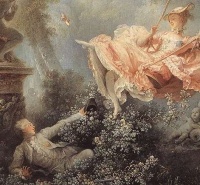French Rococo
From The Art and Popular Culture Encyclopedia
|
Related e |
|
Featured: |
French Rococo is a term used to describe the visual and plastic arts and architecture in 18th century France.
The death of Louis XIV lead to a period of licentious freedom commonly called the Régence. The heir to Louis XIV, his great grandson Louis XV of France, was only 5 years old; for the next seven years France was ruled by the regent Philippe II of Orléans. Versailles was abandoned from 1715 to 1722. Painting turned toward "fêtes galantes", theater settings and the female nude. Painters from this period include Antoine Watteau, Nicolas Lancret and François Boucher.
The Louis XV style of decoration (although already apparent at the end of the last reign) was lighter: pastels and wood panels, smaller rooms, less gilding and fewer brocades; shells and garlands and occasional Chinese subjects predominated. Rooms were more intimate. After the return to Versailles, many of the baroque rooms of Louis XIV were redesigned. The official etiquette was also simplified and the notion of privacy was expanded: the king himself retreated from the official bed at night and conversed in private with his mistress.
Main works
- Les Fêtes vénitiennes, Watteau
- Le Pierrot, Watteau
- Le Déjeuner, Boucher
- Le Bain de Diane, Boucher
- Leda and the Swan, Boucher
- Les Hasards heureux de l’escarpolette, Fragonard
- Les Baigneuses, Fragonard
- La Gimblette, Fragonard
- Le Pèlerinage sur l’ile de Cythère, Watteau
- Le Verrou, Fragonard
- Le décor intérieur de l’hôtel de Soubise, Germain Boffrand
See also
- The Goncourts on French Rococo and the cult of beauty
- Italian Rococo interior design
- French art of the 18th century
- Rococo


